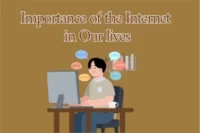What is Web Development? Complete Guide from Beginner to Advanced
Published: 14 Jul 2025
Whether you’re browsing your favorite blog, shopping online, or managing your finances through a web app, web development makes all of this possible. It’s the foundation of the internet, shaping how we interact with digital content.
In this in-depth guide, we’ll take you from what web development is to the tools, technologies, and techniques that professionals use in the industry.
What is Web Development?
Web development is the process of creating websites and web applications that are accessible through the internet. It includes everything from writing code and building layouts to configuring servers and managing databases.
It’s broadly divided into three categories:
- Front-End Development (what users see)
- Back-End Development (what powers the site)
- Full-Stack Development (a combination of both)
Why is Web Development Important?
- It powers all websites, apps, and platforms you use.
- It’s essential for businesses to have an online presence.
- Web apps help with automation, e-commerce, social networking, and more.
- It offers excellent career opportunities with high demand.
Core Components of Web Development
The following are the core components of web development that form the foundation of building functional, responsive, and user-friendly websites.
Front-End Development (Client Side)
This is what users see and interact with on the browser. It involves:
- HTML – Structure of the content
- CSS – Styling and layout
- JavaScript – Interactivity and logic
Popular Front-End Tools & Frameworks:
- React.js
- Vue.js
- Angular
- Tailwind CSS
- Bootstrap
Back-End Development (Server Side)
The back end handles logic, database operations, user authentication, and more.
Common Back-End Languages:
- Node.js (JavaScript runtime)
- PHP
- Python (Django, Flask)
- Java (Spring Boot)
- Ruby on Rails
Databases:
- SQL: MySQL, PostgreSQL
- NoSQL: MongoDB, Firebase
Full-Stack Development
A full-stack developer is skilled in both front-end and back-end, capable of building complete applications.
Popular Full-Stack Stacks:
- MERN (MongoDB, Express, React, Node.js)
- MEAN (MongoDB, Express, Angular, Node.js)
- LAMP (Linux, Apache, MySQL, PHP)
How the Web Works (Simplified)
- The user types a URL in the browser.
- DNS translates it into an IP address.
- The browser sends a request to the server.
- Server processes the request and sends back an HTML/CSS/JS page.
- The browser renders the page.
Modern sites also include:
- API calls
- Dynamic rendering
- Real-time updates (e.g., WebSockets)
Website Development Lifecycle
Developing a website isn’t just about writing code, it’s a structured process that follows several key phases to ensure the final product is functional, user-friendly, and aligned with business goals.
The following points outline the key stages involved in the Website Development Lifecycle:
1. Planning
- Define goals, features, and user needs.
2. Design
- Create wireframes, UI/UX mockups using tools like Figma or Adobe XD.
3. Development
- Code the front-end and back-end.
- Integrate APIs, payment gateways, etc.
4. Testing
- Browser compatibility
- Bug fixing
- Performance testing
5. Deployment
- Hosting on platforms like Vercel, Netlify, or DigitalOcean.
- Connect to a domain name.
- Set up SSL for HTTPS.
6. Maintenance
- Regular updates
- Backups
- Security patches
Tools Every Web Developer Should Know
| Area | Tools/Technologies |
| Code Editors | VS Code, Sublime Text |
| Version Control | Git, GitHub, GitLab |
| Package Managers | npm, yarn |
| Frontend | React, Vue, Tailwind, Sass |
| Backend | Express, Django, Laravel |
| Databases | MongoDB, PostgreSQL, Firebase |
| Deployment | Netlify, Vercel, Heroku, Docker |
| Testing | Jest, Cypress, Postman |
Web Development Trends (2025 and Beyond)
The following are the key web development trends shaping the digital landscape in 2025 and beyond. These trends help developers and businesses to stay ahead of the curve.
- Progressive Web Apps (PWA)
- Serverless Architecture
- AI-powered websites
- Headless CMS (e.g., Strapi, Sanity)
- Single Page Applications (SPA)
- WebAssembly (Wasm)
- Web3/Blockchain integration
Career Paths in Web Development
The following are the major career paths in web development, offering exciting opportunities for beginners and experienced professionals alike in today’s tech-driven world.
Job Roles
- Front-End Developer
- Back-End Developer
- Full-Stack Developer
- Web Designer
- UI/UX Designer
- DevOps Engineer
- QA Tester
Salaries (2025 Estimates)
- Junior Developer: $40,000 – $70,000/year
- Mid-Level: $70,000 – $100,000/year
- Senior Developer: $100,000 – $160,000/year
Learning Resources
- FreeCodeCamp
- GeeksforGeeks
- MDN Web Docs
- Coursera, Udemy, YouTube
Conclusion
Web development is a dynamic and rewarding field. From simple HTML pages to full-fledged SaaS platforms, developers have the tools to build anything they can imagine.
Whether you’re a complete beginner or an aspiring professional, there’s always something new to learn in web development. Start small, practice regularly, and build real projects. The internet is waiting.
If something’s still unclear or you’d like to explore a topic in more detail, feel free to leave a comment below! We’re happy to help you take the next step in your web development journey.
FAQs
Below are some important and commonly asked questions about web development to help you better understand the field.
Web development is the practice of creating websites and web applications that are accessed through the internet. It includes everything from writing simple HTML pages to building complex applications like online stores, streaming platforms, and social media networks. It combines programming, design, and server-side management to bring websites to life.
No, they are different but closely related. Web design focuses on how a website looks and feels its layout, color schemes, typography, and user experience (UX). Web development, on the other hand, involves coding and programming that powers the functionality of the site. Designers create the blueprint, and developers build it into a working product.
Yes, understanding coding is important for professional web development. Most beginners start with HTML, CSS, and JavaScript. Later, they move on to back-end languages like PHP, Python, or Node.js. Some tools like Wix or Webflow let you build websites without coding, but they have limited features.
There are three primary categories:
- Front-End Development: Deals with what users see in the browser—layouts, buttons, images, animations, etc.
- Back-End Development: Handles the server, database, and application logic, ensuring everything functions behind the scenes.
- Full-Stack Development: A combination of both front-end and back-end skills, allowing developers to build complete solutions.
This depends on your learning path, prior experience, and commitment. If you study consistently, you can build a basic understanding of web development in 3 to 6 months. Becoming job-ready often takes 6 to 12 months, especially if you’re learning full-stack development. Real-world experience through projects is just as important as theory.
Web developers use a wide range of tools depending on their role. Common tools include:
- Code Editors
- Version Control
- Frameworks & Libraries
- Databases
- Testing Tools
- Deployment Platforms
Yes, web development remains one of the most in-demand and future-proof career paths. With businesses expanding their online presence and new web technologies emerging, the need for skilled developers continues to grow. It also offers flexibility, remote work options, and competitive salaries across the globe.
Absolutely! Many developers are self-taught using online resources such as YouTube, freeCodeCamp, Codecademy, and documentation like MDN Web Docs. With dedication, practice, and building real projects, you can learn at your own pace and build a strong portfolio without needing a formal degree.
A website is typically a collection of static or informational pages, like blogs or company landing pages. A web app is a dynamic, interactive platform that allows users to perform tasks—such as sending messages, placing orders, or managing data. Examples of web apps include Gmail, Facebook, and Trello.
Web development is rapidly evolving with exciting trends like:
- AI and Machine Learning integration
- Progressive Web Apps (PWAs)
- Serverless computing
- Headless CMS
- Web3 and blockchain-based applications

- Be Respectful
- Stay Relevant
- Stay Positive
- True Feedback
- Encourage Discussion
- Avoid Spamming
- No Fake News
- Don't Copy-Paste
- No Personal Attacks

- Be Respectful
- Stay Relevant
- Stay Positive
- True Feedback
- Encourage Discussion
- Avoid Spamming
- No Fake News
- Don't Copy-Paste
- No Personal Attacks





